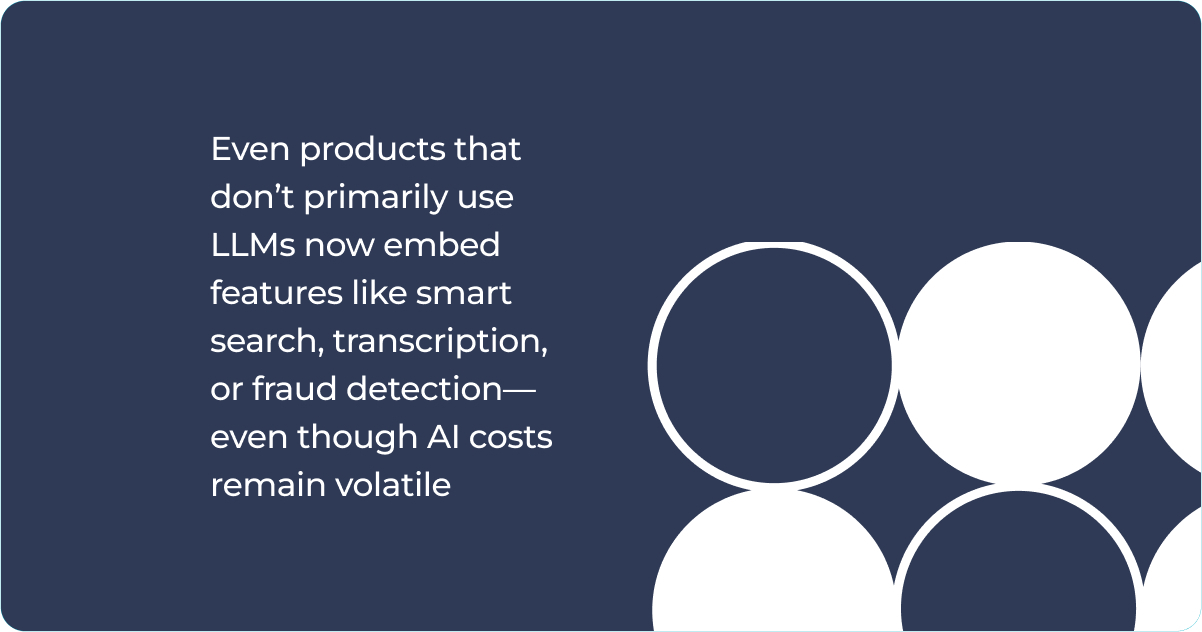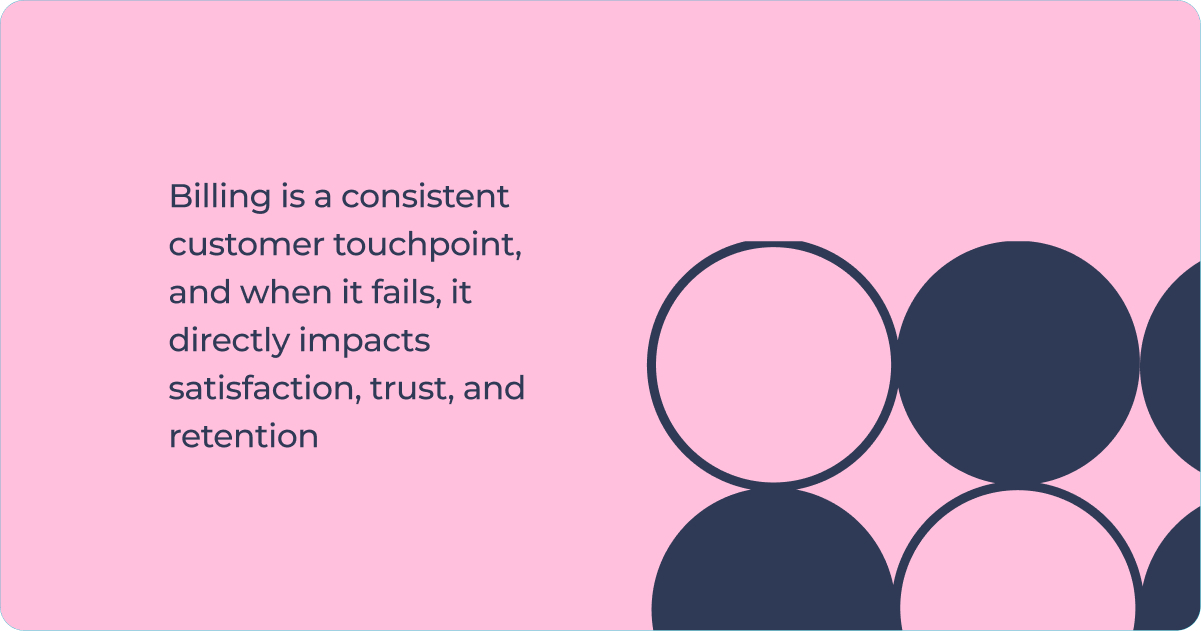Usage-based pricing has always promised fairness. Customers pay for what they use, and businesses grow as adoption scales. Generative AI raises the stakes by introducing unpredictable consumption patterns and volatile costs that challenge even the most established models. The real challenge isn’t whether usage-based pricing works—it’s making sure it works in a world defined by AI-driven volatility.
Why “the age of GenAI” Changes Usage-Based Pricing for Everyone
Usage-based pricing has already become the standard across SaaS and service-based businesses, so it’s no surprise that the model is being adapted to genAI services as well. Customers appreciate paying for what they actually consume, while vendors benefit from closer alignment between usage and revenue.
Generative AI is pushing this model further. Even products that don’t primarily use LLMs or genAI now embed features like smart search, transcription, or fraud detection. At the same time, AI costs remain volatile, and larger context windows or multimodal models only increase the variability.
What used to be steady, subscription-based revenue is now unpredictable. In the age of GenAI, variability is the rule, not the exception, meaning it's essential to rethink how usage is metered, priced, and billed with transparency.
New Demand Patterns & Value Metrics (even if your SKU isn’t “AI”)
AI doesn’t just create more demand; it changes how customers use your product. Features like auto-classification, summarize-on-save, real-time translation, or fraud detection often run in the background, quietly consuming resources with every click or query. As context windows expand and voice or image processing becomes standard, each interaction generates more activity than before.
To keep pricing aligned with value, providers are moving beyond simple “per seat” or flat subscription fees. New meters are emerging that track:
- Gigabytes of data analyzed
- API calls or events processed
- AI requests per project or workflow
- Minutes of audio or video transcribed
- Different service levels, such as real-time vs. batch processing
This complexity creates tension. Customers only want to pay for the value they receive, while finance leaders need predictability in budgets and forecasts. Hybrid models act as the middle ground—offering a predictable base of included units, with the flexibility to handle overages, credits, or commits. The result is a structure that balances fairness for customers with financial stability for providers.
Pricing Patterns for 2025 (principles you can copy)
Generative AI has pushed SaaS and service-based companies to rethink how they price. The old world of simple, fixed subscriptions no longer reflects the reality of variable consumption. Here are five principles you can apply to your pricing strategy:
- Hybrid models create balance
Relying on a single subscription tier is no longer enough. Successful companies are combining a steady base fee with usage-based components, such as tiered allowances or pay-as-you-go overages. This hybrid approach ensures you have predictable recurring revenue while still capturing upside from heavy users who consume more than average. - Transparency builds trust
Customers are quick to question invoices they don’t understand, especially when usage spikes because of AI-driven workloads. Businesses that clearly explain how costs are calculated, and present line items in plain language, create confidence and reduce billing disputes. - Flexibility drives agility
The pace of innovation in AI means your pricing model can’t stand still. Companies winning in 2025 are experimenting with bundles, prepaid credits, and regional or tier-based pricing. This flexibility gives sales teams room to tailor deals without breaking finance’s ability to report and forecast accurately. - Value-based metrics resonate
Pricing is most effective when it matches what customers see as value. Instead of charging for abstract technical units like compute cycles, providers are aligning pricing with business-relevant outcomes like minutes of transcription delivered, gigabytes analyzed, or AI tasks completed. When buyers can directly connect cost to benefit, adoption accelerates. - Cost controls protect margins
AI infrastructure costs remain volatile. Companies that want to avoid margin erosion are baking protections into their pricing. Tiered discounts, commit-based models, and region- or latency-based markups all help ensure profitability, even when supplier costs fluctuate.
The Billing Infrastructure You Actually Need
Rethinking pricing is only half the battle. To make usage-based models work in the GenAI era, you need billing infrastructure that can keep up with complex data, contracts, and compliance. Here are the five building blocks every provider needs:
- Ingestion and mediation
Usage data doesn’t come from just one place, it flows in from your core application, third-party AI services, and countless other systems. To make sense of it all, you need a way to centralize the data. When ingestion and mediation work seamlessly, you avoid double-counting, capture late-arriving records, and ensure every charge starts with clean, reliable data.' - Metering
Raw events on their own don’t mean much. They need to be translated into business-ready metrics like minutes transcribed, gigabytes processed, or requests served. By aggregating usage into daily or hourly windows, you improve accuracy, make forecasting easier, and catch anomalies before they ever appear on an invoice. - Rating
Once usage is metered, pricing logic needs to be applied. This is where tiered and volume-based models, commits, discounts, and regional or latency-based markups come into play. Storing customer-specific exceptions in a single source of truth keeps billing consistent and auditable. - Contract synchronization
Quotes shouldn’t live in isolation from billing. If a sales team offers custom terms, those terms must flow seamlessly into enforceable billing rules. Without this synchronization, businesses risk revenue leakage, customer disputes, and endless reconciliation headaches. - Billing, invoicing, and revenue recognition
Finally, the entire process must close the loop. Automated billing generates charges as they happen, invoices display clear and itemized line items, and entries flow directly into AR, GL, and revenue recognition systems. Compliance with standards like ASC 606 and IFRS 15 isn’t optional, it’s built in. - Customer Trust: Transparency Beats Bill Shock
The biggest risk with usage-based pricing is losing trust. Customers want predictability, even when their consumption is unpredictable. That means giving them visibility and control over how usage turns into charges.
The companies getting this right make billing feel fair and manageable. They give customers real-time usage dashboards, send alerts as thresholds or budgets are reached, set caps to prevent runaway costs, and deliver itemized invoices that spell out every charge. Combined with tools like included units, commits, and usage limits, these practices turn potential “bill shock” into confidence that pricing is transparent and under control.
Where Good Sign Fits
GenAI has made usage-based pricing more complex and more powerful than ever. To succeed, you need infrastructure that keeps contracts, usage data, pricing, and billing perfectly in sync. Good Sign’s contract-centric revenue management platform eliminates manual work, prevents revenue leakage, and gives finance and product leaders the flexibility and transparency they need to launch new models with confidence. In a market where unpredictability is the new normal, Good Sign helps SaaS and service providers eliminate leakage, protect margins, and scale revenue with ease.



